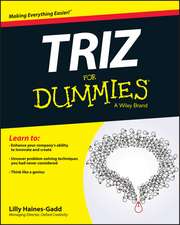Advances in the Theory of Shock Waves: Progress in Nonlinear Differential Equations and Their Applications, cartea 47
Editat de Heinrich Freistühler Contribuţii de T.-P. Liu Editat de Anders Szepessy Contribuţii de G. Metivier, J. Smoller, B. Temple, W.-A. Yong, K. Zumbrunen Limba Engleză Hardback – 26 iun 2001
| Toate formatele și edițiile | Preț | Express |
|---|---|---|
| Paperback (1) | 651.99 lei 6-8 săpt. | |
| Birkhäuser Boston – 24 oct 2012 | 651.99 lei 6-8 săpt. | |
| Hardback (1) | 658.55 lei 6-8 săpt. | |
| Birkhäuser Boston – 26 iun 2001 | 658.55 lei 6-8 săpt. |
Din seria Progress in Nonlinear Differential Equations and Their Applications
-
 Preț: 281.13 lei
Preț: 281.13 lei - 15%
 Preț: 643.34 lei
Preț: 643.34 lei - 18%
 Preț: 735.38 lei
Preț: 735.38 lei - 18%
 Preț: 893.40 lei
Preț: 893.40 lei - 18%
 Preț: 1129.99 lei
Preț: 1129.99 lei - 15%
 Preț: 586.23 lei
Preț: 586.23 lei - 18%
 Preț: 1128.57 lei
Preț: 1128.57 lei - 18%
 Preț: 903.21 lei
Preț: 903.21 lei - 18%
 Preț: 788.54 lei
Preț: 788.54 lei - 18%
 Preț: 784.13 lei
Preț: 784.13 lei -
 Preț: 399.12 lei
Preț: 399.12 lei - 15%
 Preț: 640.71 lei
Preț: 640.71 lei - 18%
 Preț: 1012.84 lei
Preț: 1012.84 lei - 18%
 Preț: 1010.17 lei
Preț: 1010.17 lei - 18%
 Preț: 953.97 lei
Preț: 953.97 lei -
 Preț: 383.33 lei
Preț: 383.33 lei - 15%
 Preț: 586.85 lei
Preț: 586.85 lei - 5%
 Preț: 657.34 lei
Preț: 657.34 lei - 15%
 Preț: 635.47 lei
Preț: 635.47 lei -
 Preț: 386.61 lei
Preț: 386.61 lei -
 Preț: 402.56 lei
Preț: 402.56 lei - 15%
 Preț: 704.36 lei
Preț: 704.36 lei - 15%
 Preț: 519.47 lei
Preț: 519.47 lei -
 Preț: 386.00 lei
Preț: 386.00 lei -
 Preț: 391.02 lei
Preț: 391.02 lei -
 Preț: 393.90 lei
Preț: 393.90 lei - 18%
 Preț: 954.93 lei
Preț: 954.93 lei -
 Preț: 387.96 lei
Preț: 387.96 lei - 15%
 Preț: 644.82 lei
Preț: 644.82 lei - 18%
 Preț: 890.37 lei
Preț: 890.37 lei - 15%
 Preț: 642.18 lei
Preț: 642.18 lei -
 Preț: 391.99 lei
Preț: 391.99 lei - 18%
 Preț: 966.15 lei
Preț: 966.15 lei - 18%
 Preț: 789.35 lei
Preț: 789.35 lei
Preț: 658.55 lei
Preț vechi: 774.76 lei
-15% Nou
Puncte Express: 988
Preț estimativ în valută:
126.01€ • 131.58$ • 104.06£
126.01€ • 131.58$ • 104.06£
Carte tipărită la comandă
Livrare economică 16-30 aprilie
Preluare comenzi: 021 569.72.76
Specificații
ISBN-13: 9780817641870
ISBN-10: 0817641874
Pagini: 520
Ilustrații: VIII, 520 p.
Dimensiuni: 155 x 235 x 30 mm
Greutate: 0.92 kg
Ediția:2001
Editura: Birkhäuser Boston
Colecția Birkhäuser
Seria Progress in Nonlinear Differential Equations and Their Applications
Locul publicării:Boston, MA, United States
ISBN-10: 0817641874
Pagini: 520
Ilustrații: VIII, 520 p.
Dimensiuni: 155 x 235 x 30 mm
Greutate: 0.92 kg
Ediția:2001
Editura: Birkhäuser Boston
Colecția Birkhäuser
Seria Progress in Nonlinear Differential Equations and Their Applications
Locul publicării:Boston, MA, United States
Public țintă
ResearchCuprins
I. Well-Posedness Theory for Hyperbolic Systemsof Conservation Laws.- 1. Scalar conservation law.- 2. Glimm scheme.- 3. Wave tracing.- 4. Nonlinear functional.- II. Stability of Multidimensional Shocks.- 1. The uniform stability condition.- 2. The uniform stability estimates.- 3. Well posedness of the linearized shock front equations.- 4. The existence of multidimensional shocks.- 5. Stability of weak shocks.- III. Shock Wave Solutions of the Einstein Equations:A General Theory with Examples.- 1. Introduction.- 2. Solutions of the Einstein equations when the metricis only Lipschitz continuous across an interface.- 3. Matching an FRW to a TOV metric across a shock wave.- 4. A class of exact shock wave solutions of the Einstein equations — blast waves in GR.- 5. Cosmology with a shock wave.- 6. General comments on FRW–CTOV shock waves.- 7. The Oppenheimer–CSnyder limit and the solution for k = 0.- IV. Basic Aspects of Hyperbolic Relaxation Systems.- 1. Introduction.- 2. Relaxation criterion.- 3. The Chapman–CEnskog expansion.- 4. Admissible boundary conditions.- 5. Stability conditions.- 6. Typical examples.- 7. Moment closure systems.- 8. Discrete velocity kinetic models.- 9. Relaxation limits for smooth solutions.- 10. Shock structure problems.- V. Multidimensional Stability of Planar Viscous Shock Waves.- 1. Introduction.- 2. The Evans function and its low frequency limit.- 3. Necessary conditions for stability.- 4. Sufficient conditions for stability.- 5. Pointwise bounds for scalar equations.- 6. One-dimensional stability: the stability index.- 7. Discussion and open problems.- 8. Appendices: extensions and auxiliary calculations.
















